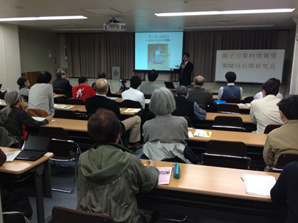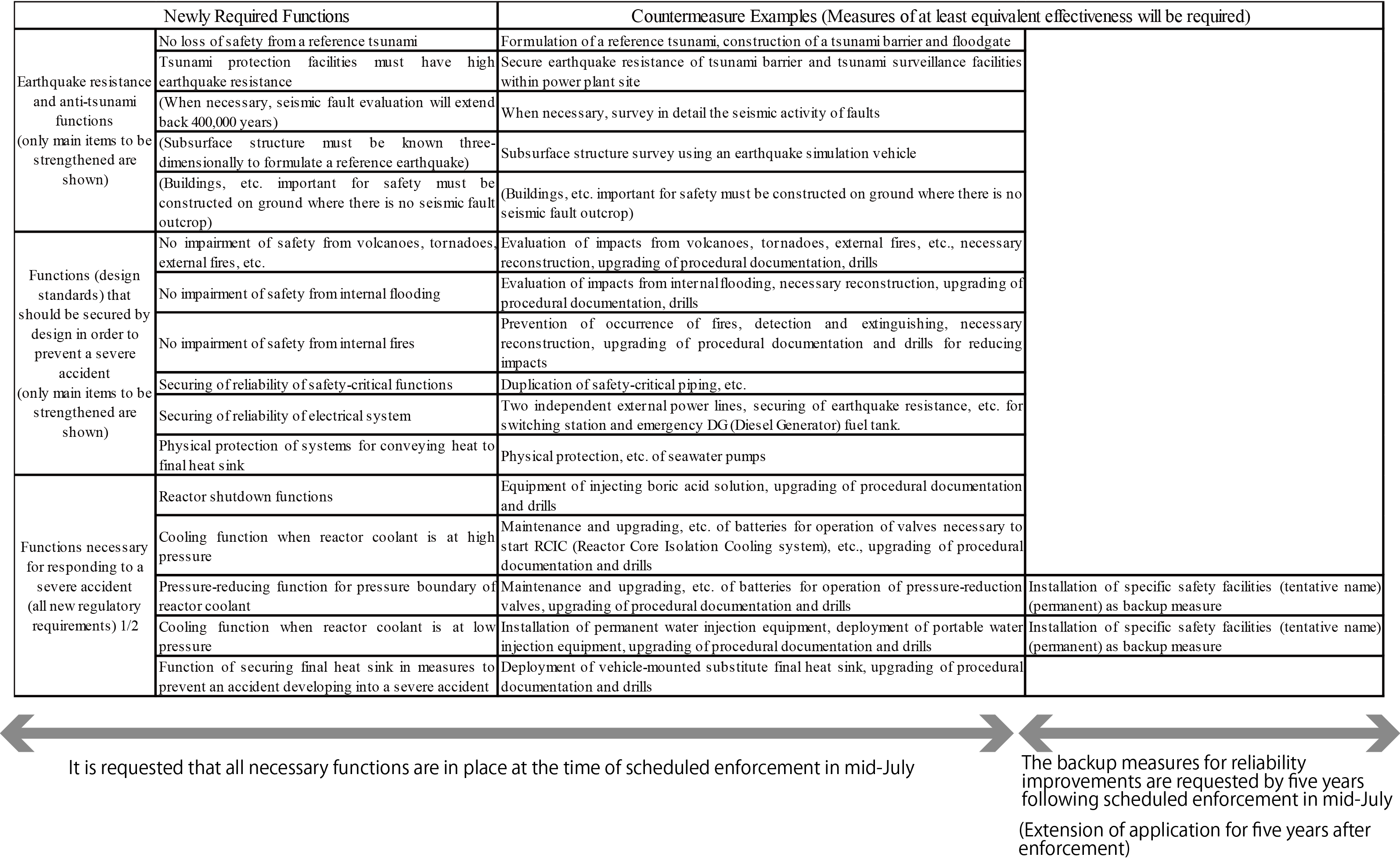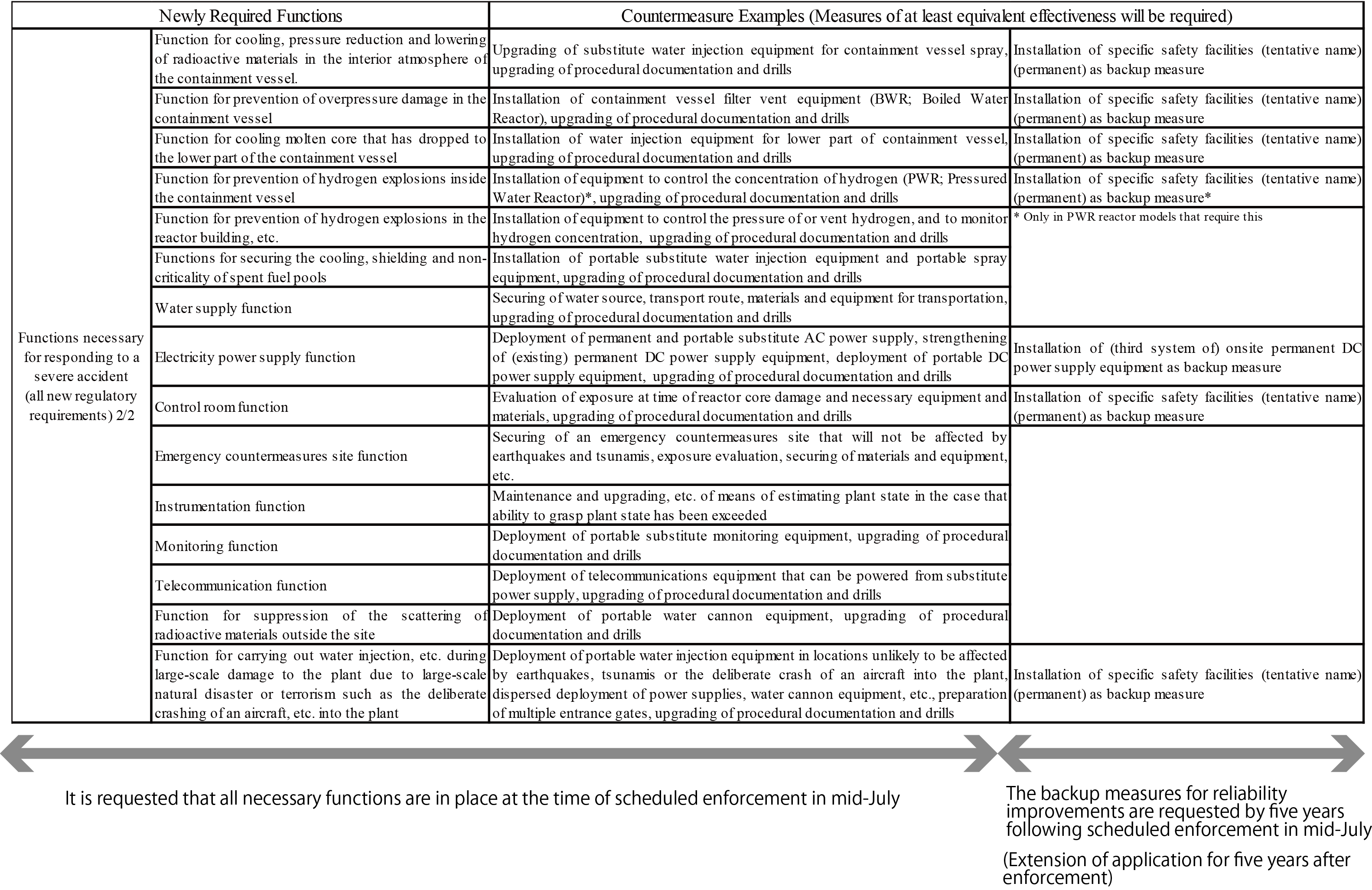 |
The Photo of 82nd CNIC Public Research Meeting
|
The Nuclear Regulation Authority
(NRA) accepted public comments on its new safety standards for
nuclear power reactors during the 30 days from 11 April to 10 May.1 To stimulate the interest of citizens in
this public comment opportunity, CNIC invited Mr. Satoshi Sato, a
former nuclear power plant engineer who is very well versed in the
details of global nuclear power plant safety standards, to give a
commentary on the new draft safety standards at a public research
meeting on 26 April.2 Below is a report
on the talk given by Mr. Sato.
1. A short deliberation
period on a wide-ranging topic
In February this year (2013), the NRA solicited public comments on the
Draft Framework for Safety Standards (design criteria, severe accident
countermeasures, and earthquake/tsunami countermeasures), allowing
three weeks for comments. In fact, these documents were nothing more
than a rehash of the General Criteria prepared by the US Nuclear
Regulatory Commission (NRC) in 1967. The period allowed for public
comments for the General Criteria was two months.
This time, the NRA has set a period of 30 days for
comments on the Draft Safety Standards, 27 documents consisting of over
3,000 pages, based on one part of the NRA Draft Framework for Safety
Standards. Included in these are the regulations for research reactors
such as the fast breeder reactor Monju.
Management capabilities at Fukushima Daiichi Nuclear
Power Station have been deteriorating on a daily basis, leading to a
situation where the management has even been made to look like a fool
by a rat.3 Does the NRA truly have the
time to deal with safety standards for Monju and reprocessing in a
situation like this? The NRA should be aware of the concerns about
nuclear power that are spreading among the citizens of this country.
In spite of this, the regulations relating to
research reactors have been prepared at the same time as those for
commercial nuclear power plants. It can only be thought that the NRA is
attempting to dilute the public comments. I feel very strongly the
differences in safety culture between Japan and the West.
2. The limits of safety
standards and safety culture
Safety standards are one part of the
regulatory infrastructure, and even if reactors pass the reviews and
inspections these do not necessarily guarantee their safety.
The safety review of nuclear power plants should not
consist only of the screening of documents; an onsite inspection is
also absolutely necessary. The NRC, for example, carries out reviews in
its Maryland headquarters, and inspections are carried out on a
continual basis by the inspector based at each nuclear power plant and
each regional inspector. It is not the case at all that inspections are
over after just one visit to a power plant.
Also, in the case of the US regulatory system, there
are firstly laws and regulations, the details of which are indicated in
regulatory guidelines, in which civil criteria and notifications are
referred to. Nevertheless, however meticulous the regulatory structure
may be, there are always a large number of loopholes.
It is therefore extremely important to build up a
safety culture where those involved make a positive and collective
effort to block off the loopholes.
3. The erosion of
defense in depth
The basis of the safety functions of
nuclear reactors are the three functions of shutting down (the nuclear
reaction), cooling (the nuclear reactor) and containing (radioactive
material).
Nuclear power plants are built so that in the event
of a LOCA (Loss Of Coolant Accident) a large number of safety devices,
such as the ECCS (Emergency Core Cooling System) operate automatically
to secure these three safety functions (defense in depth). Therefore,
at first glance, it appears that nuclear power plants can be operated
safely.
In Japan’s nuclear industry, however, the fact is
that defense in depth and safety culture have continually been pushed
into the background.
For instance, since the 1970s the industry has been
plagued with the problem of the “stress corrosion cracking”4 of nuclear reactor piping. Naturally,
this has also occurred in Japan, but the nuclear industry has not
publicized this fact, and has replaced the cracked pipes and so on
under the name of preventive maintenance.
In addition, although as a general rule defense in
depth is demanded “in principle,” there are many cases where exceptions
are allowed. Despite the suppression pool having an extremely important
function for safety, once it is damaged, it cannot be replaced. The
high pressure system of the ECCS is supplied with water from the
condensate storage tank, but there is only one of these tanks. There is
also only one fuel tank for the diesel engines.
4. Five angles for the
safety regulations
Under previous safety evaluation guidelines, loss of
external power supply, deterioration of the containment vessel, damage
to the nuclear reactor building and so on were thought to be impossible
from an engineering point of view and were therefore excluded from
consideration. However, all the accidents that were thought to be
impossible happened at Fukushima Daiichi Nuclear Power Station.
Further, according to Site Evaluation Application Criteria, even if
such accidents were to occur, it was thought that the amount of
radioactive material released would be within a certain permissible
limit and would be within the confines of the nuclear power plant site,
but at Fukushima 10,000 times the assumed amount of radioactive
material was released. This indicates that Site Evaluation Application
Criteria and the safety evaluation guidelines are mistaken and should
be reviewed.
Having workers take part in emergency operations under
conditions that involve exposure to high levels of radiation is a
breach of the Constitution and the Labor Standards Act. Despite this,
everything is permitted since it is an emergency. In order to have
people take part in emergency operations, informed consent and
voluntarism are indispensible.
In the case of fire prevention, the nuclear power plant’s
fire fighting team is only supposed to carry out initial fire fighting
activities until the local fire department arrives, but as there are
many hazards in nuclear power plants it should be the power plant’s
fire fighting team, which is familiar with the site, that handles all
emergencies rather than an external fire department.
In Seismic Design, in the four serious earthquakes that
have occurred in Japan since 2005, tremors exceeding the standard
earthquake have occurred five times. I think that the lack of an
intention to change this lax earthquake resistance policy should be
seen as a problem. The earthquake resistance strength is also dealt
with only at the analytical level, but this is inadequate since we
cannot know what is happening inside components with a complex
structure, such as electronic equipment, simply by analysis;
experiments should actually be carried out and earthquake-proof models
accredited.
What ought to be the greatest source of trust at a nuclear
power plant is the power company’s own safety culture. Up to now,
however, the power companies have shown the most enthusiasm for
whittling away safety standards. Thus it is necessary to build up a
culture of safety.
5. Conclusion
Nuclear power plants began with
Eisenhower’s “Atoms for Peace” speech. At present, however, we are
rushing forward in a very dangerous direction. The next generation will
face great torment if regulations are not strengthened.
Postscript
The NRA began work in September 2012.
The legal basis for its foundation, the Act for the Establishment of
the Nuclear Regulatory Authority, stipulates that the various safety
standards for nuclear power plants shall be established by July 2013.
On this basis, the NRA has been working quickly since last year to
formulate the safety standards. At the 11th NRA meeting on 19 July
2013, the draft safety standards, slightly amended on the basis of the
public comments, were approved and it was decided that the new safety
standards would be enforced from 8 July. As Mr. Sato pointed out in his
talk, the formulated safety standards have many problems which have not
been resolved even having passed through the public comments process.
In this section I would like to point out the
problems of the safety standards by focusing on two points. One is the
problem of the screening and assessment system and the other is a
problem of the procedure for formulating the safety standards.
The first problem, that of the assessment system, is
an extremely important one. In the case of the assessment system for
restarting the nuclear power plants that are now shut down, the power
companies make an application to the effect that they are carrying out
safety measures based on the safety standards, which is then assessed
by the Secretariat of the NRA and approved by the NRA Commission.
The new safety standards do not contain any criteria
in the form of certain standards that have to be met. It is left to the
power companies to consider what kind of protection measures to
formulate and to take countermeasures. The NRA Secretariat then
confirms whether or not the protection measures will be able to fully
cope with the risks laid out in the safety measures, and this is
finally approved by the NRA Commission. It is thought that a “safety
culture” will be built up within the power companies through this
process.
However, the vast majority of the staff of the NRA
Secretariat have simply shifted across from the former Nuclear and
Industrial Safety Agency (NISA) – just those people who have been
pointed out as being “regulatory captives” in the past. It is these
people, who have made scant effort to look back at the Fukushima
Daiichi Nuclear Power Station accident, who will screen the
documentation submitted by the power companies and carry out the onsite
inspections, and it is these power companies who are now choking in red
ink due to the current heavy reliance on thermal power generation,
desperately screaming that all will be fine if only the nuclear power
plants could be operated, and yet who at present have not a shred of
“safety culture.”
With no clear regulatory criteria, power companies
lacking in safety culture, and a staff of “regulatory captives” who
have simply shifted sideways and are continuing to carry out
regulation, can we have confidence safety will be guaranteed? It is
extremely doubtful.
The second point concerns the procedure of the
formulation of the safety standards. During the period when the safety
standards were being formulated there was absolutely no explanation to
citizens, and although the opinions of the power companies were sought,
those of other knowledgeable people who are critical of nuclear power
were not. In addition, while opportunities to submit public comments
were implemented twice, the submission periods were short and the
opinions sent in were hardly reflected in the formulation process at
all.
Nuclear power plants are extremely complex systems
that make comprehensive use of a wide range of skills and knowledge.
Yet despite the fact that after the experience of March 11, 2011 three
accident inquiry commissions, the National Diet of Japan Fukushima
Nuclear Accident Independent Investigation Commission, the Japanese
Government Investigation Committee on the Accident at the Fukushima
Nuclear Power Stations, and the (private) Independent Investigation
Commission on the Fukushima Nuclear Accident, all pointed out that
there were great flaws in the existing regulatory procedures, the
formulation of the new safety standards, which according to the NRA
Commissioner Toyoshi Fuketa “would normally take five years,” were
completed in a mere ten months and almost entirely by interested
parties. This is a huge problem.
Given the large number of criticisms of the safety
standards, even if there is a statutory limit on the formation of the
standards, should the law be amended to allow careful and thorough
consideration of their formulation?
As the new safety standards are enforced, the power
companies submitted their applications for restarting nuclear power
plants. Applications for 12 nuclear power plants have already been
handed in: Hokkaido Electric Power Company’s Tomari Nuclear Power
Station Unit 1-3, Kansai Electric Power Company’s Ohi Nuclear Power
Station Unit 3 and 4, Takahama Nuclear Power Station Unit 3 and 4,
Shikoku Electric Power Company’s Ikata Nuclear Power Station Unit 3, as
well as Kyushu Electric Power Company’s Genkai Nuclear Power Station
Unit 3 and 4, Sendai Nuclear Power Station Unit 1 and 2.
A staff of 80 in three teams in the NRA Secretariat
will screen the applications, a process which is expected to take at
least six months.
(Hajime Matsukubo, CNIC)
1: http://www.cnic.jp/5083
2: http://www.cnic.jp/movies/5090
3: Nuke Info Tokyo 154
News Watch
4: Stress Corrosion Cracking is the
cracking induced from the combined influence of stress and a corrosive
environment.
 |
 |
Return to
Nuclear Safety page
Return to NIT 155 contents




